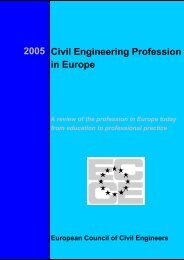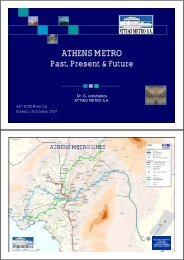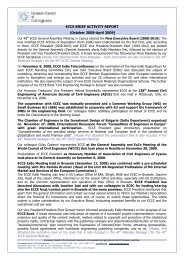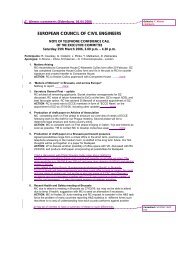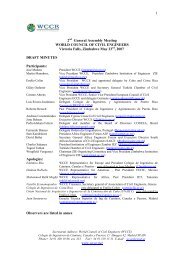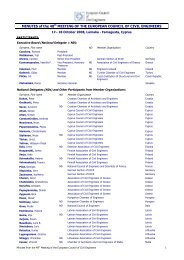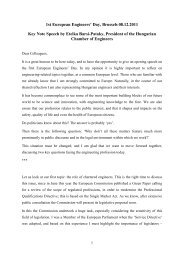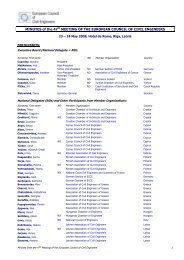A Closer Look at Prevailing Civil Engineering Practice - European ...
A Closer Look at Prevailing Civil Engineering Practice - European ...
A Closer Look at Prevailing Civil Engineering Practice - European ...
You also want an ePaper? Increase the reach of your titles
YUMPU automatically turns print PDFs into web optimized ePapers that Google loves.
A <strong>Closer</strong> <strong>Look</strong> <strong>at</strong> <strong>Prevailing</strong> <strong>Civil</strong> <strong>Engineering</strong> <strong>Practice</strong>, Wh<strong>at</strong>, Why and How<br />
Vincent T. H. CHU<br />
Chapter 9. Site Investig<strong>at</strong>ion<br />
1. Wh<strong>at</strong> is the difference between Dynamic Probing and Standard<br />
Penetr<strong>at</strong>ion test<br />
Standard Penetr<strong>at</strong>ion Test (SPT) is an in-situ dynamic penetr<strong>at</strong>ion test to<br />
provide inform<strong>at</strong>ion on the properties of soil. It may also collect a disturbed<br />
soil sample for grain-size analysis and soil classific<strong>at</strong>ion. SPT involves the<br />
driving of a standard sampler through a distance of 450mm into the bottom<br />
of a borehole using the standard weight of 63.5kg falling through 760mm.<br />
Dynamic Probing Test as per BS1377: Part 9: 1990 involves the driving of<br />
a metal cone into the ground through a series of 1-metre length steel rods.<br />
These rods are driven from the surface by the hammer system on the rig<br />
which drops 63.5 kg weight onto the rods through a fall of 760mm. The<br />
number of blows th<strong>at</strong> is required to drive the cone down each 100mm<br />
increment is then recorded until a required depth is reached or a refusal is<br />
achieved. Dynamic Probing has many applic<strong>at</strong>ions. For instance, it may be<br />
used to estim<strong>at</strong>e the depths of <strong>at</strong> the interface between hard and soft str<strong>at</strong>a<br />
and to trace the outline of objects buried underground.<br />
SPT test is used to provide valuable inform<strong>at</strong>ion on soil properties.<br />
However, the main use of dynamic probing is to interpol<strong>at</strong>e inform<strong>at</strong>ion<br />
between boreholes/trial pits swiftly and to supplement inform<strong>at</strong>ion found<br />
from boreholes and trial pits <strong>at</strong> a low cost. For instance, dynamic probing is<br />
carried out close to a borehole where the underground conditions are<br />
identified. As such, by using the dynamic probing, the result of borehole<br />
can be extended to other areas in between two boreholes.<br />
2. Wh<strong>at</strong> is the difference between trial pit, trial trench and inspection<br />
pit<br />
A trial pit is used for obtaining inform<strong>at</strong>ion on the subsurface soil conditions.<br />
It allows logging of the various soils types and soil sampling. Typical size of<br />
trial pits has minimum base plan area of 1.5m 2 . Trial trench serves the<br />
same purpose of trial pit except th<strong>at</strong> they differ in size and dimension. For<br />
instance, the length of a trial trench is normally larger than its width by a<br />
certain factor (e.g. 5) to c<strong>at</strong>er for its “trench” shape.<br />
An inspection pit is a pit used for identifying and positioning of underground<br />
utilities and structure.<br />
66




